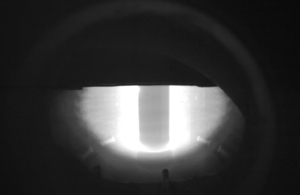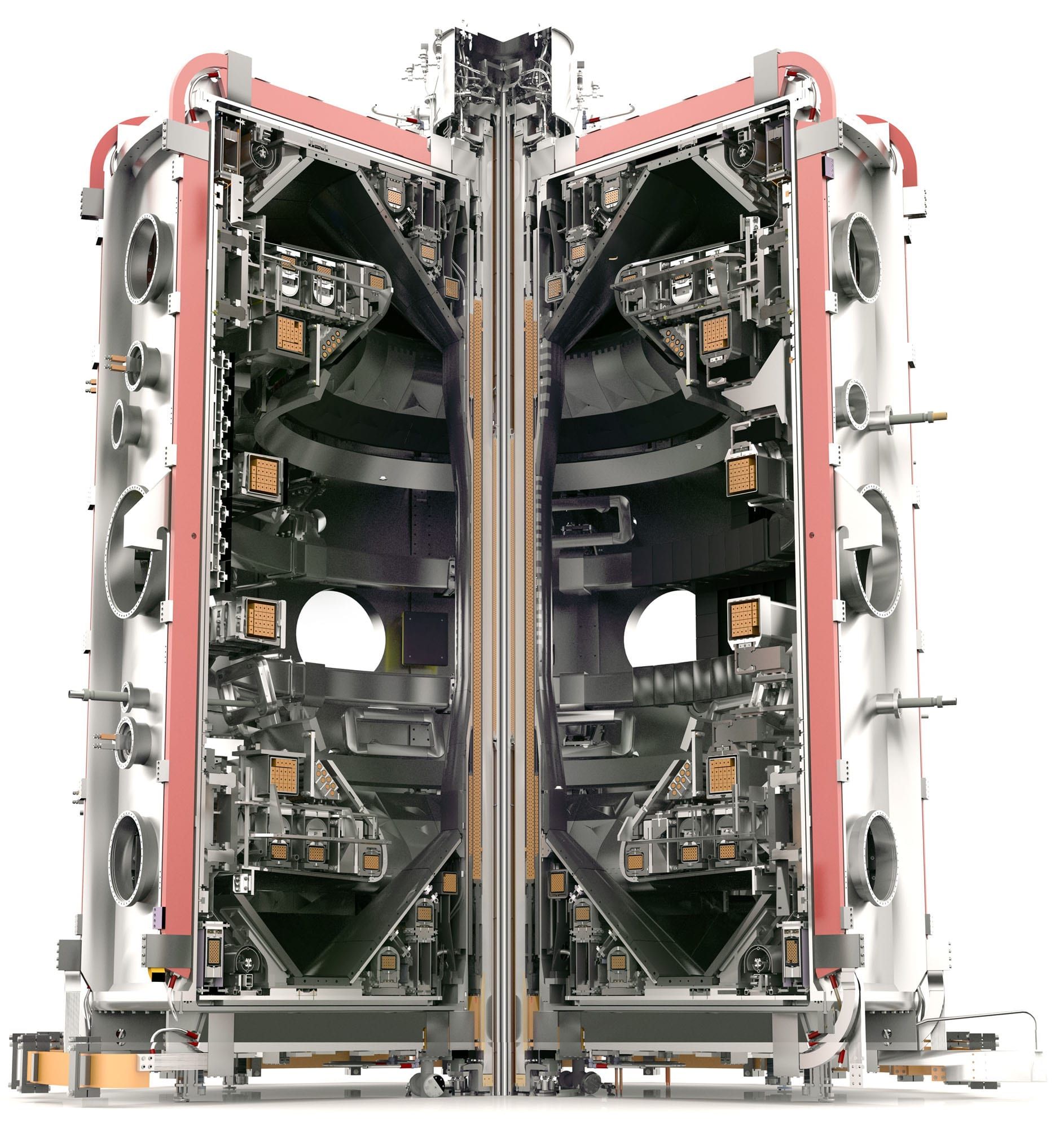A flash of purple plasma followed by applause echoing over a video connection: on 29 October 2020, the UK's new fusion device MAST Upgrade officially commenced operation. DIFFER has helped to develop a new imaging system and the control engineering systems to stabilize the plasma.
Source: EUROfusion, Gieljan de Vries
The result of a seven-year upgrade programme of UKAEA's Mega Ampere Spherical Tokamak, MAST Upgrade is essentially a completely new machine. The 3-meter-wide device – bigger than an Airbus A380 engine – now features stronger magnets, extra instrumentation to follow and control the seething plasma within, increased heating power in the form of stronger neutral beam injectors and the capability to make its plasma discharges longer, up to 5 seconds.

First plasma in the MAST Upgrade spherical
tokamak. Photo: UKAEA.
EUROfusion Programme Manager Tony Donné: "We are looking forward to the scientific results from this machine with its super-long divertor leg, which will give important guidance to ITER and DEMO."
Fusion researchers throughout Europe followed MAST Upgrade's first plasma discharge via remote video connection. The spherical tokamak’s thin centre column is different than the workhorse donut-shape of mainstream devices like JET and ITER, but the
European fusion community considers it a worthwhile alternative to explore on its Roadmap to Fusion Energy. UKAEA thinks the compact design may hold the key to small and affordable future fusion power plants. UKAEA CEO Prof Ian Chapman: "This experiment will break new ground and test technology that has never been tried before. MAST Upgrade will be vital in achieving UKAEA’s goal of building the STEP fusion power plant by 2040."
DIFFER
DIFFER was involved in this project in two ways: through diagnostics and control engineering. The new multispectral imaging system of MAST Upgrade, the Multi Wavelength Imager (MWI), is based on the design of MANTIS; a real-time multispectral imaging system for fusion plasmas. MANTIS was recently developed in a collaboration between MIT-PSFC (Robert Mumgaard), EPFL (Basil Duval), and DIFFER (Wouter Vijvers). It acquires the optical emission from plasmas to provide input for analysis to obtain its density and temperature. Those parameters can be used to gain further information about the concentration and effect of impurities on the edge plasma which can then be used for active impurity enrichment. The MWI implements solutions from MANTIS and goes one step further to extend the design by a coherence imaging cell designed for the plasma flow measurements.
The DIFFER researchers also ran simulations to prove that the developed algorithm for the imaging systems, validated on the TCV tokamak, could deliver useful input to the exhaust control system in the new complex divertor geometry of MAST Upgrade.
Moreover, students from DIFFER and the TU/e participated in other research projects on control engineering as well, particularly the vertical stabilization of the plasma in MAST-U. The DIFFER scientists involved were Ivo Classen, Matthijs van Berkel and Marco de Baar, and their research groups.

Super X: sitting on the surface of the Sun
MAST Upgrade's crown jewel has to be its complex new divertor or exhaust, designed to efficiently cool outflowing plasma and protect the exhaust wall. Typically the inner walls of a tokamak are protected from the super-hot plasma contained inside by magnetic fields. The exception is the divertor, which has to survive temperatures and particle impacts only seen on the surface of the Sun. MAST Upgrade was designed to try out new ways of cooling the hot plasma before it touches and erodes the divertor during a normal plasma exhaust process.
To cool the plasma, new magnetic coils near MAST Upgrade's divertor will shape and stretch the exhaust stream into exotic shapes like the stretched Super X or multipronged Snowflake. These give the plasma more time and space to radiate away energy before it finally reaches the divertor wall. By reducing the wear and tear on the divertor, this technique is expected to result in longer lifetimes for future fusion power plants.
Small, flexible machine
MAST Upgrade is a spherical tokamak; it has a narrow profile, or aspect ratio. A traditional tokamak has a toroidal confinement area. The spherical tokamak reduces the size of the hole as much as possible, resulting in a plasma shape that is almost spherical. The British fusion researchers refer to it as a cored apple. "The design of a spherical tokamak lets you get the same level of plasma confinement with a much smaller magnetic field", explains UKAEA media manager Nick Holloway over Skype. "If we get this right, we'll have another possible design for a fusion power plant." At the same time, MAST Upgrade is similar enough to mainstream tokamaks that results can be easily transferred between them.
MAST Upgrade will run for 10 experimental days in December 2020, and more to come in 2021.
More information
Website MAST Upgrade
EUROfusion Roadmap to Fusion Energy
News story on EUROfusion (source)
DIFFER Groups
Energy Systems & Control, group leader Matthijs van Berkel
Plasma Edge Physics and Diagnostics, group leader Ivo Classen
DIFFER Publications
Development of a real-time algortihm for detection of the divertor detachment radiation front using multi-spectral imaging, Nuclear Fusion.
MANTIS: A real-time quantitative multispectral imaging system for fusion plasmas, Review of Scientific Instruments.
Go to the News page.